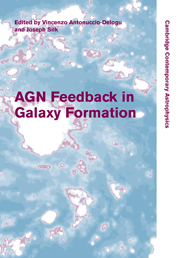Book contents
- Frontmatter
- Contents
- List of contributors
- Preface
- The organising committees
- Part I AGNs, starbursts and galaxy evolution
- Part II Co-evolution of black holes and galaxies
- 5 The symbiosis between galaxies and SMBHs
- 6 On the origin of halo assembly bias
- 7 AGN, downsizing and galaxy bimodality
- Part III Outflows and radio galaxies
- Part IV Models and numerical simulations: methods and results
- Index
5 - The symbiosis between galaxies and SMBHs
from Part II - Co-evolution of black holes and galaxies
Published online by Cambridge University Press: 10 November 2010
- Frontmatter
- Contents
- List of contributors
- Preface
- The organising committees
- Part I AGNs, starbursts and galaxy evolution
- Part II Co-evolution of black holes and galaxies
- 5 The symbiosis between galaxies and SMBHs
- 6 On the origin of halo assembly bias
- 7 AGN, downsizing and galaxy bimodality
- Part III Outflows and radio galaxies
- Part IV Models and numerical simulations: methods and results
- Index
Summary
Introduction
A fundamental issue when modeling the evolution of galaxies in a cosmological context is that the majority of the processes driving baryonic evolution (such as star formation, various feedback mechanisms, accretion onto supermassive black holes (SMBHs)) operate or originate on scales well below the resolution of any feasible simulation in a cosmic box. Moreover, these processes are highly nonlinear, poorly understood from a physical point of view, and approximated by means of simplified, often phenomenological, and thus uncertain subgrid prescriptions. Unfortunately, yet unsurprisingly, a number of studies have clearly demonstrated that the results of these models are heavily affected by different choices for such prescriptions (e.g. Benson et al. 2003; Di Matteo et al. 2005), or for parameter values (e.g. Zavala et al. 2008). It is fair to say that first principles or ab-initio models do not exist.
Standard SAMs, their successes and their failures
Extensive comparisons between different scenarios and data are generally conducted by means of semi-analytic modeling (SAMs) for baryons, often grafted onto gravity-only simulations for the dark matter (DM) evolution. By the definition of SAMs, the general behavior of the system is outlined a priori, and then translated into a set of (somewhat) physically grounded analytical recipes – suitable for numerical computation over cosmological timescales – for the processes that are thought to be more relevant to galaxy formation and evolution.
- Type
- Chapter
- Information
- AGN Feedback in Galaxy Formation , pp. 41 - 46Publisher: Cambridge University PressPrint publication year: 2010

